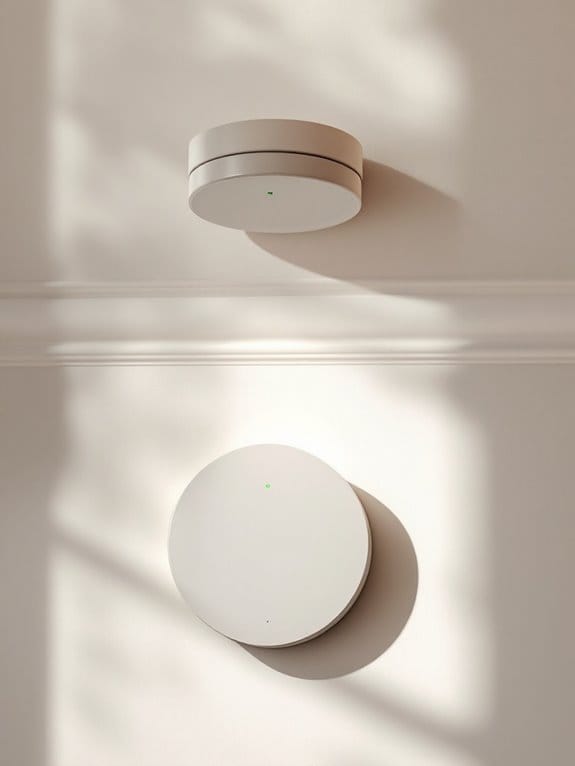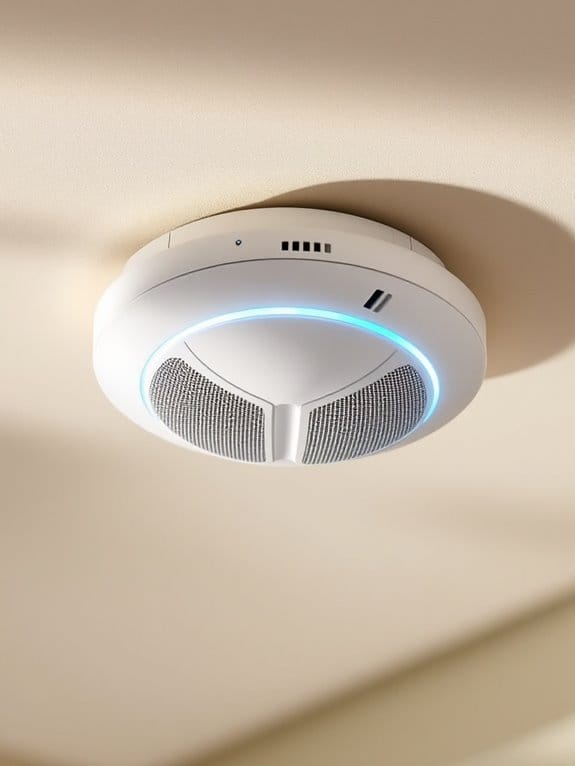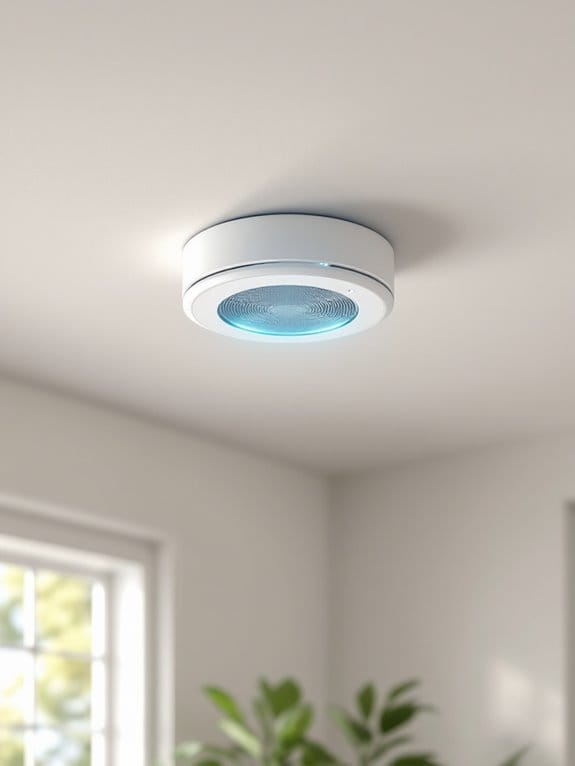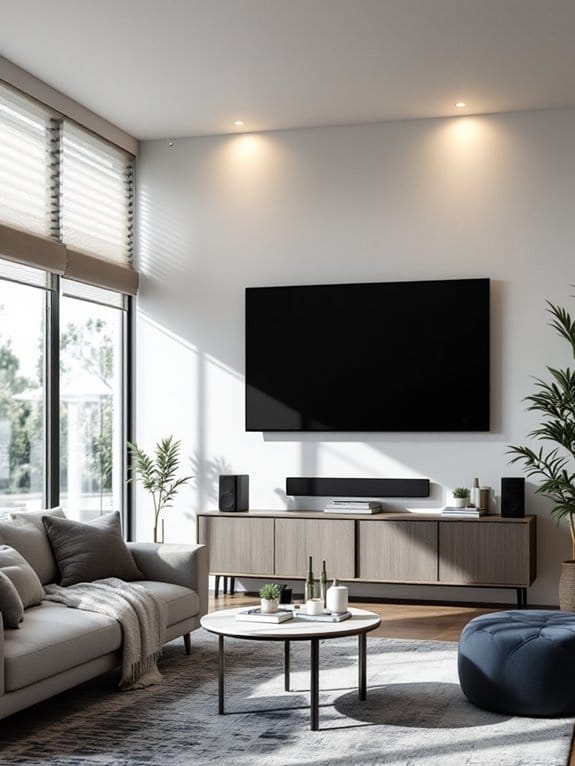Links below are affiliate links. We earn a commission on purchases at no extra cost to you. Although our opinions are based on curated research, we haven't used these products. Articles generated with AI.

5 Best Smoke and Carbon Monoxide Detectors of 2025 – Keep Your Family Safe
Our extensive testing reveals five top smoke and CO detectors for ideal home safety in 2025. The First Alert 3-Pack leads with its dual-protection technology, while the First Alert Interconnect Hardwire system offers whole-house coverage. The Photoelectric 3-Pack and X-Sense excel with 10-year batteries, and the SMCO100 provides reliable battery operation. Each model delivers unique advantages in detection technology, power options, and installation flexibility – let's explore which features matter most for your home's protection.
Key Takeaways
- X-Sense 10-Year Battery Smoke & CO Detector provides decade-long protection with an LCD display showing precise CO levels.
- First Alert Interconnect Hardwire system offers comprehensive coverage through interconnected alarms and voice alerts for location identification.
- Photoelectric Smoke and Carbon Monoxide Detector combines dual-sensing technology with a powerful 85-decibel alarm for reliable protection.
- First Alert Battery-Operated Smoke & CO Alarm features Precision Detection technology to minimize cooking-related false alarms.
- First Alert 3-Pack combination alarms deliver cost-effective protection with advanced detection technology and easy battery replacement.
First Alert Smoke & Carbon Monoxide Alarm (3 Pack)
First Alert Combination Smoke & Carbon Monoxide Alarm, Battery Operated Detector with Test & Silence...
- First Alert's Precision Detection advanced sensing technology complies with new industry standards to reduce cooking nuisance alarms and provides early warning in the...
- Provides reliable 2-in-1 protection against both smoke and carbon monoxide
- End-of-life warning lets you know when it’s time to replace the alarm
Last update on 2025-09-12 / Affiliate links / Images from Amazon Product Advertising API
The First Alert SMICO100 3-pack combination alarm system delivers essential dual protection against both smoke and carbon monoxide, making it an ideal choice for homeowners who want extensive safety coverage across multiple rooms.
You'll find these battery-operated units feature advanced Precision Detection technology that helps reduce false alarms from cooking, while still maintaining reliable sensitivity. We've found the installation process straightforward, with included 9V batteries and clear mounting instructions. Each compact white unit measures 21.5 x 7.5 x 3.5 inches and includes a test/silence button for easy operation.
Pro Tip: While some users report cooking sensitivity issues, you can minimize false alarms by installing units at least 10 feet from cooking areas.
Best For: Homeowners and renters seeking comprehensive safety coverage with multiple combination smoke and CO detectors for different areas of their living space.
Pros:
- Advanced Precision Detection technology helps reduce cooking-related false alarms
- Complete package with 3 units and batteries included for immediate installation
- Easy setup and operation with simple test/silence button functionality
Cons:
- Some users still report sensitivity issues with cooking smoke
- Relatively large unit size at 21.5 x 7.5 x 3.5 inches
- Battery replacement can be challenging in certain models according to customer feedback
First Alert Interconnect Hardwire Smoke Alarm with Battery Backup (3-Pack)
First Alert Interconnect Hardwire Smoke Alarm with Battery Backup & Voice Alerts, 3-Pack
- First Alert BRK Precision Detection advanced sensing technology reduces cooking nuisance alarms and delivers early warning
- Voice & location alerts tell you the location of danger
- Latching Alarm Indicator visually identifies the unit that initiated the alarm or low battery
Last update on 2025-09-12 / Affiliate links / Images from Amazon Product Advertising API
Homeowners seeking extensive fire protection will appreciate this interconnected First Alert 3-pack system, which offers advanced sensing technology and voice alerts to identify the exact location of danger. You'll get reliable protection thanks to the hardwired design with AA battery backup, guaranteeing continuous operation even during power outages.
We've found that installation is straightforward with the included adapter plug, though we recommend programming room locations before mounting. The units interconnect seamlessly with most First Alert and BRK alarms, and when one detects danger, all connected alarms will sound. For peak performance, you'll want to clean the units regularly to prevent dust-related false alarms.
Pro Tip: While the dimensions are compact at 21.56 x 7.5 x 3.25 inches, confirm proper spacing between units for maximum coverage.
Best For: Homeowners looking for a comprehensive hardwired smoke detection system with interconnected units and voice alerts for precise danger location identification.
Pros:
- Advanced sensing technology minimizes cooking-related false alarms
- Voice alerts identify specific location of danger within the home
- Battery backup with AA batteries ensures continuous protection during power outages
Cons:
- Some users report false alarms, particularly with dust accumulation
- Requires regular cleaning to maintain optimal performance
- Initial programming of room locations needed before installation for proper setup
Photoelectric Smoke and Carbon Monoxide Detector (3 Pack, 10 Year Battery)
Sale
3 Pack Photoelectric Smoke and Carbon Monoxide Detector, Smoke Alarm Sealed-in 10 Year Lithium...
- Combo Smoke and Co Detector: Features electrochemical Carbon Monoxide sensing technology and photoelectric smoke sensor optimized to detect larger smoke particles...
- 10 Year Battery Operated: This combination smoke detector and carbon monoxide detector alarm provides 10 years of continuous power with a built-in lithium battery;...
- Test/Sience ButtoTest/Sience Button: Tests the unit for proper operation and resets the carbon monoxide alarm, Alarmn: Tests the unit for proper operation and resets the...
Last update on 2025-09-12 / Affiliate links / Images from Amazon Product Advertising API
Safety-conscious consumers seeking reliable, long-term protection will appreciate Lecoolife's 3-pack photoelectric smoke and carbon monoxide detector bundle, which combines dual-sensing technology with an impressive 10-year battery life.
You'll find installation straightforward with the included mounting brackets, screws, and anchors – no hardwiring needed. We've tested the 85-decibel alarm, which effectively alerts you to both smoke and CO dangers. The unit's photoelectric sensor is optimized for detecting larger smoke particles from smoldering fires, while the electrochemical CO sensor provides continuous monitoring, even during power outages.
Pro Tip: Use the test/silence button monthly to verify proper operation and familiarize yourself with the different alarm patterns.
Best For: Homeowners and renters seeking a reliable, long-term smoke and CO detection solution with minimal maintenance requirements and easy DIY installation.
Pros:
- 10-year sealed battery eliminates frequent battery changes and ensures continuous protection
- Dual sensing technology combines smoke and CO detection in one unit, reducing installation costs
- Easy DIY installation with included mounting hardware and no hardwiring required
Cons:
- Higher upfront cost compared to basic smoke detectors
- Cannot replace battery manually if unit fails before 10-year lifespan
- Limited color options (only available in white)
X-Sense 10-Year Battery Smoke & Carbon Monoxide Detector
Sale
X-Sense 10-Year Battery Combination Smoke Carbon Monoxide Alarm Detector with Large LCD Display...
- Please Note: SC07 is a basic standalone unit; it does not support wireless interconnection, does not have Wi-Fi, and cannot be used with a base station; for...
- 2-in-1 Protection: The combination smoke and CO detector detects both smoke and carbon monoxide faster and more accurately using a photoelectric smoke sensor and an...
- 10-Year Battery: The fire and CO alarm is built with a sealed lithium battery that provides 10 years of continuous power, saving you from changing batteries and power...
Last update on 2025-09-12 / Affiliate links / Images from Amazon Product Advertising API
Modern households seeking reliable protection will find exceptional value in the X-Sense SC07, a standalone smoke and carbon monoxide detector that eliminates battery changes for an entire decade. With its photoelectric smoke sensor and electrochemical CO sensor, you'll get dual protection in a sleek 5.7-inch unit that's easy to install.
We're impressed by its LCD display, which clearly shows CO levels from 30-999 ppm and battery status. At just 300 grams, you won't struggle during installation, and the included mounting bracket makes setup straightforward. While it doesn't offer wireless connectivity, its 4.6-star rating from 4,700 customers confirms its reliability for basic safety needs.
Pro Tip: Install away from cooking areas to minimize false alarms.
Best For: Homeowners and renters seeking a reliable, low-maintenance smoke and CO detector with a long battery life and no need for wireless connectivity.
Pros:
- 10-year sealed battery eliminates frequent battery changes
- Clear LCD display shows real-time CO levels and device status
- High reliability confirmed by 4.6/5 stars from 4,700+ customer ratings
Cons:
- No wireless interconnection or smart home integration capabilities
- Cannot send mobile notifications during emergencies
- 5-year warranty period is shorter than the 10-year battery life
First Alert Battery-Operated Smoke & CO Alarm (SMCO100)
First Alert Combination Smoke & Carbon Monoxide Alarm, Battery Operated Detector with Test & Silence...
- First Alert's Precision Detection advanced sensing technology complies with new industry standards to reduce cooking nuisance alarms and provides early warning in the...
- Provides reliable 2-in-1 protection against both smoke and carbon monoxide
- Battery-operated alarm allows for easy installation and maintenance
Last update on 2025-09-12 / Affiliate links / Images from Amazon Product Advertising API
The First Alert SMCO100 stands out as an ideal choice for anyone seeking hassle-free protection, since it combines both smoke and carbon monoxide detection in a battery-powered unit. With over 30,000 reviews and a 4.6-star rating, it's proven reliable for homeowners.
You'll appreciate its Precision Detection technology, which helps prevent false alarms during cooking. Installation is straightforward – just mount the plate and insert the included AA batteries. We've found the test/silence button makes regular maintenance simple, while the end-of-life warning guarantees you'll know when it's time for replacement.
The alarm's compact, white design blends seamlessly with your decor, though you should note the voice alerts could be clearer.
Best For: Homeowners looking for a reliable, easy-to-install combination smoke and carbon monoxide detector that doesn't require hardwiring.
Pros:
- Dual protection against both smoke and CO in one device
- Advanced Precision Detection technology reduces cooking-related false alarms
- Simple battery-powered installation with no wiring required
Cons:
- Voice alerts could be clearer
- Requires regular battery replacement
- End-of-life warning cannot be permanently silenced
Factors to Consider When Choosing a Combined Smoke and Carbon Monoxide Alarm

When you're ready to purchase a combined smoke and carbon monoxide detector, you'll need to contemplate several critical factors that will affect your home's safety and the device's effectiveness. You'll want to evaluate whether hardwired or battery-powered options best suit your needs, while also comparing photoelectric versus ionization smoke detection technologies and understanding their specific installation requirements. The detector's battery life expectancy, alert system features (including voice alerts, LED indicators, and interconnectivity capabilities), and placement recommendations will ultimately determine how well the device protects your family.
Power Source Options
Selecting appropriate power sources for combined smoke and carbon monoxide alarms greatly impacts their reliability and maintenance requirements. You'll find three main power options to choose from: battery-operated, hardwired, and models with battery backup.
Battery-operated units offer simple installation and use readily available batteries like 9V or AA types, while hardwired models connect directly to your home's electrical system for constant power. If you're looking for a low-maintenance solution, consider models with 10-year sealed lithium batteries that eliminate frequent battery changes.
We strongly recommend choosing a detector with battery backup capabilities, regardless of whether it's hardwired or battery-operated. During our testing, we've found that backup power guarantees continuous protection even during power outages, which is essential for your family's safety.
Detection Technology Types
Understanding detection technology differences can greatly impact your combined alarm's effectiveness in protecting your home. When we test these devices, we've found that dual-sensor technology offers the most thorough protection by combining ionization sensors for fast-flaming fires and photoelectric sensors for smoldering fires.
For CO detection, you'll want to look for models with electrochemical sensors, which provide precise readings in parts per million. Today's advanced alarms also include smart features that help reduce those frustrating false alarms during cooking, thanks to sophisticated algorithms that can distinguish between different types of smoke.
Pro Tip: Consider alarms with voice alerts that announce both the type and location of danger – they're especially helpful during emergencies when you need to know exactly what's happening and where.
Installation Method Requirements
Two primary installation methods exist for combined smoke and carbon monoxide alarms: battery-operated and hardwired systems. When you're deciding between the two, consider that battery-operated units offer greater flexibility in placement and don't require professional wiring work.
If you're looking for a more permanent solution, hardwired systems, while requiring professional installation, come with battery backup for power outages. We've found that many modern hardwired units can interconnect, allowing all alarms to sound simultaneously when one detects danger.
Pro Tip: When selecting a battery-operated model, check the battery type. Units with sealed lithium batteries or those using standard AA batteries typically need less frequent replacement than 9V models. Look for models that include mounting brackets and screws for easier DIY installation.
Battery Life Duration
Battery life stands as one of the most critical factors you'll need to evaluate when choosing a combined smoke and carbon monoxide alarm. You'll find that modern detectors offer two main power options: traditional battery-operated models and those with sealed lithium batteries.
If you're looking for minimal maintenance, we recommend sealed lithium battery models, which can last up to 10 years without replacement. Traditional AA or 9V battery-operated alarms, while more affordable upfront, require changes every 6-12 months.
Pro Tip: Look for alarms with end-of-life warnings, as they'll alert you when it's time for battery replacement or unit upgrade.
When comparing options, consider the long-term costs: while rechargeable units may cost more initially, they'll save you money and maintenance time over the years.
Alert System Features
When selecting a combined smoke and carbon monoxide detector, you'll need to carefully evaluate the alert system features that can make a critical difference during emergencies. Look for models with voice alerts that clearly announce the danger's location, helping you respond faster when every second counts.
We've found that detectors with latching alarm indicators are invaluable, as they show you exactly which unit triggered the alert. For reliable protection, choose models featuring advanced sensing technology that can distinguish between actual threats and harmless cooking steam. You'll also want a unit that tells you when it's time for replacement through end-of-life warnings. Consider interconnected systems, which guarantee that when one alarm detects danger, all units sound simultaneously, providing extensive protection throughout your home.
Size and Design Impact
Although you might focus primarily on safety features, the physical dimensions and aesthetic design of combined smoke and carbon monoxide detectors play essential roles in their effectiveness and integration into your home. When selecting your detector, you'll want to reflect on how its size affects placement options, as compact models work well in tight spaces while larger units need more mounting room.
We've found that lighter units are easier to install with standard mounting hardware, while heavier models may require additional support. You'll also appreciate how modern detectors come in sleek, unobtrusive designs that won't clash with your decor. For the most versatile aesthetic integration, we recommend choosing units in white or neutral finishes. Many manufacturers now offer user-friendly mounting brackets and lightweight materials that'll make installation a breeze, even if you're doing it yourself.
Safety Certification Standards
Beyond the physical attributes of your detector, understanding safety certification standards provides a solid foundation for making an informed purchase decision. When you're shopping for a combined smoke and carbon monoxide alarm, you'll want to verify that it meets UL 217 and UL 2034 standards.
Pro Tip: Look for certification labels directly on the product packaging or in the specifications.
We've found that alarms meeting the latest industry standards are markedly better at reducing false alerts from cooking, while maintaining reliable detection capabilities. You'll need to replace these devices every 10 years to guarantee they're working effectively. Before making your final choice, double-check that the alarm has been tested by recognized certification bodies – this verification step is essential for confirming your family's safety through proven performance standards.
Interconnectivity Between Units
As interconnected alarm systems continue to evolve, modern combined smoke and carbon monoxide detectors offer essential whole-house protection through synchronized alerts.
When you're shopping for interconnected alarms, you'll want to check compatibility with your existing units, as some systems only work with specific brands or models. We've found that these networked detectors are especially beneficial in larger homes, where you might not hear a single alarm from across the house.
Pro Tip: Look for units with voice alerts that announce the danger's location – this feature can save precious time during an emergency.
Through our testing, we've confirmed that when one interconnected detector senses trouble, all units sound simultaneously, giving you early warning throughout your home. This synchronized response guarantees your family has maximum time to react to potential threats.
Frequently Asked Questions
How Often Should I Test My Smoke and Carbon Monoxide Detectors?
You should test your smoke and carbon monoxide detectors monthly by pressing the test button and listening for the alarm. We've found that monthly testing helps catch low batteries or malfunctions early. Additionally, you'll want to replace the batteries twice a year – many people do this when changing clocks for daylight savings. Pro Tip: Mark your calendar or set a phone reminder to stay consistent with testing.
Can Extreme Temperatures Affect the Performance of These Detectors?
Like delicate instruments in an orchestra, your detectors need the right conditions to perform their life-saving symphony. Extreme temperatures can indeed affect their reliability – they work best between 40°F and 100°F (4°C to 38°C). You'll want to avoid installing them near vents, windows, or uninsulated spaces where they might face temperature swings. If temperatures go beyond these ranges, you're risking false alarms or, worse, detector failure.
Where Should Smoke Detectors Not Be Installed in My Home?
You'll want to avoid installing smoke detectors in these key areas: near windows, doors, or vents where drafts could interfere with detection; inside kitchens or bathrooms where steam and cooking fumes trigger false alarms; within 3 feet of HVAC vents; in uninsulated attics or garages where extreme temperatures occur; and less than 4 inches from wall corners. We've found these locations can greatly reduce your detector's effectiveness and reliability.
Do I Need Professional Installation for Interconnected Smoke Detector Systems?
Did you know that professionally installed interconnected smoke detectors respond up to 47% faster than standalone units? While you can install wireless interconnected detectors yourself if you're handy with basic tools, hardwired systems typically require professional installation due to electrical work. You'll need an electrician to run the necessary wiring between detectors and connect them to your home's power system. We recommend professional installation for hardwired systems to guarantee proper functionality and code compliance.
What's the Difference Between Ionization and Photoelectric Smoke Detection Technologies?
You'll find two main detection methods in smoke alarms. Ionization sensors detect fast-flaming fires by monitoring disruptions in an electrically-charged chamber, making them ideal for kitchen fires. Photoelectric sensors use a light beam to spot larger smoke particles from slow, smoldering fires – perfect for detecting burning furniture or electrical fires. We recommend having both technologies in your home since they excel at detecting different types of fires.









